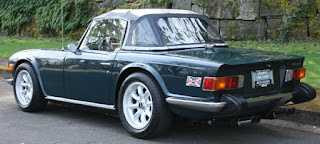We all do things that are not good for us. Binge watching Battlestar Galactica, following presidential campaigns, and consuming doughnuts are easily identifiable as things that may not be beneficial to your health. But sometimes it is necessary to eat Krispy Kremes until your blood sugar transitions to sugar, sans blood. Knowing it is not good for you only makes it that much sweeter. But when a chosen activity falls into the easily identifiable “sin” category, then there must be a reckoning. In the case of overconsumption of fried dough, it usually involves trips to the gym and the consumption of leafy green things.
Driving a particularly fast car aggressively reminds me of something that might be bad for your soul. It certainly feels good enough to be a sin. Maybe it is OK to drive a fast car like a normal person, but what good is having a fast car if it is never enjoyed. It seems innocent enough, but every time the rear tires lose traction, an angel in heaven gets a sharp stick in the eye. Somebody is going to have to pay for that. Usually, the payback is dirty looks from pedestrians, bald rear tires, and wasted fuel. But let’s be frank here, who cares what pedestrians think. If their opinion mattered they would have enough money to buy a car instead of walking. As for fuel, it is cheap and tires, while not exactly inexpensive, are easily replaced. So the downsides, when considered logically, are negligible. But there is still the matter of your soul to consider, and guilt from overindulgence is crippling as an empty fuel tank.
Still, there is a way to polish one's aura and maintain a completely impractical, fragile, frighteningly powerful, and stunningly beautiful Aston Martin DB9. Your savior, in this case, is the dorkiest car in recent memory. The Nissan Leaf. As it turns out, used electric cars are basically worthless. Unless it is a Tesla. Cars like the Leaf and the iMiEV from Mitsubishi are pioneers in the electric car industry if you don’t count golf carts. They are practical, allowing you to actually drive a hundred miles or so before plugging in. They are well made, eerily quiet, and considerably quicker than one would assume. And if you charge it at the grocery store, the operating costs are almost zero. Still, everybody with these ugly little cars refuses to rely on them exclusively. They always have a “normal” car to take on vacation or to grandma’s house. As a result, the used market is full of low mileage, basically new electric cars. And because they are a bit of an unknown quantity, they are shockingly cheap. We are talking less than $6,000 for a four or five year old Leaf with 40,000 miles on it.
Cheap electric cars may be your ticket to heaven. I am obviously not talking about the Leaf driving experience. What I am talking about is the justification for purchasing a DB9, or a 69 Camaro, or even an old Jaguar. Most people around here spend that kind of money on a truck, not a second-hand supercar. The real problem with owning an exotic or classic or heavily modified car is not that it is cramped or that it wastes gas, it is the fact that it must be relied upon for daily transport. It would be certifiably crazy to drive an Aston Martin or Lotus or Ferrari or classic muscle car to work every day. At some point, the damn thing will let you down. As a result, most people never take the chance on owning a car that would truly make them happy. It is still a car, after all.
But why not take that money and buy something you really want? Something fast, low, and beautiful. Something with three times the cylinders you need. Something with seats sewn by a single seamstress in Gaydon, Warwickshire, England. Something James Bond has been seen in. Something made by craftsmen, not robots. And then drive the thing for pleasure alone. Use the Leaf, which is a ludicrously small investment, to get to work and the grocery store. Use the Aston Martin to allow your soul to sing.
Anything that can bring that much joy can not be all bad. Repentance might even be found in a sinful car, as long as its existence can be justified by using a dependable and parsimonious electric car for normal transportation. You could even get a "this car hugs polar bears" bumper sticker for both cars without it being ironic.















































